Teaching Your Horse to Yield the Forequarters: A Step-by-Step Guide

Teaching your horse to yield the forequarters is an essential skill that improves communication, responsiveness, and overall riding harmony. This article will guide you through the process with clear instructions, helpful tips, and answers to common questions.
What Does Yielding the Forequarters Mean?

Yielding the forequarters involves asking your horse to move its front end laterally away from your leg pressure while keeping the hindquarters mostly in place. This movement increases suppleness and obedience, making it easier to navigate tight spaces and improve balance.
Why Teach Your Horse to Yield the Forequarters?
- Improves Flexibility: Helps your horse become more supple and responsive.
- Enhances Control: Allows better maneuvering in confined areas.
- Builds Trust: Strengthens the communication between you and your horse.
Step-by-Step Training Process
| Step | Description | Tips |
|---|---|---|
| 1 | Establish a Calm Environment: Begin in a quiet area free from distractions. | Use a familiar arena or paddock. |
| 2 | Apply Leg Pressure: Gently press your inside leg at the girth to signal the horse to move away. | Keep your leg steady and consistent. |
| 3 | Use the Reins for Support: Slightly open the inside rein to guide the horse’s head away from the pressure. | Avoid pulling harshly; be gentle. |
| 4 | Reward Small Movements: As soon as the horse moves its forequarters, release pressure and praise. | Use treats or verbal encouragement. |
| 5 | Increase Difficulty Gradually: Practice in different locations and with varying distractions. | Be patient and consistent. |
Common Mistakes to Avoid
- Applying too much leg pressure, causing confusion or resistance.
- Pulling on the reins instead of using them for guidance.
- Rushing the training process without rewarding progress.
Frequently Asked Questions (FAQ)
Q1: How long does it take to teach a horse to yield the forequarters?
A: The time varies depending on the horse’s temperament and previous training but expect several sessions over a few weeks.
Q2: Can yielding the forequarters help with other riding disciplines?
A: Yes, it improves overall responsiveness and is beneficial in dressage, trail riding, and jumping.
Q3: What if my horse resists moving sideways?
A: Check your cues for clarity, reduce pressure, and ensure you’re rewarding even small attempts.
Teaching your horse to yield the forequarters is a rewarding process that enhances your partnership and riding skills. With patience and consistent practice, your horse will respond willingly and confidently to your cues.
